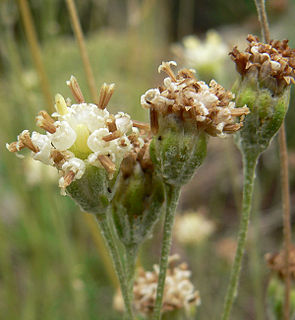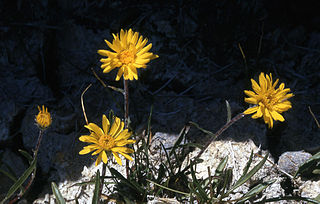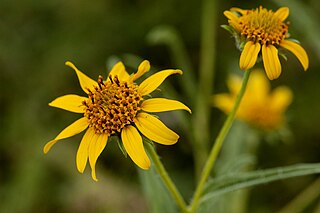Eriophyllum multicaule is a North American flowering plant in the daisy family, known by the common name manystem woolly sunflower. It is native to California and Arizona in the southwestern United States.

Eryngium aristulatum, known by the common names California eryngo and Jepson's button celery, is a species of flowering plant in the family Apiaceae.

Gnaphalium palustre, known by the common name western marsh cudweed, is a species of flowering plant in the family Asteraceae.

Hymenopappus filifolius is a North American species of flowering plant in the daisy family known by the common names fineleaf hymenopappus and Columbia cutleaf. It is native to western and central North America from Alberta and Saskatchewan south as far as Chihuahua and Baja California.
Lasthenia glaberrima is a species of flowering plant in the daisy family known by the common names smooth goldfields and rayless goldfields. It is native to western North America from British Columbia to California, where it grows in wet places such as vernal pools and springtime meadows.
Euphorbia hooveri is a species of euphorb known by the common names Hoover's sandmat and Hoover's spurge. It is endemic to California, where it grows in the rare vernal pools of the Central Valley. Due to the elimination of most of its habitat, it became a federally listed threatened species in 1997.

Enceliopsis nudicaulis is a North American species of flowering plants in the daisy family known by the common name nakedstem sunray, or naked-stemmed daisy.
Eriophyllum ambiguum is a species of flowering plant in the aster family known by the common name beautiful woolly sunflower. It is native to the deserts and adjacent hills of southern and eastern California, northwestern Arizona, and southern Nevada.
Juncus kelloggii is a species of rush known by the common name Kellogg's dwarf rush.
Minuartia californica, commonly known as California sandwort, is a species of flowering plant in the family Caryophyllaceae.

Psilocarphus is a genus of flowering plants in the pussy's-toes tribe within the daisy family.
Myosurus sessilis is a species of flowering plant in the buttercup family known by the common name vernal pool mousetail. It is native to southern Oregon and the Central Valley of California, where it grows in vernal pools and other wet grassland habitat. It is an annual plant forming a small tuft up to about 10 centimeters tall. The leaves are narrow and linear in shape, measuring up to 7 centimeters in length. The inflorescence produces a single flower which has an elongated, cylindrical or cone-shaped receptacle up to 3 centimeters long. At the base of the receptacle are curving, spurred sepals and three to five tiny petals.

Navarretia fossalis is a rare species of flowering plant in the phlox family known by the common name spreading navarretia.
Psilocarphus elatior is a species of flowering plant in the aster family known by the common names tall woollyheads, meadow woollyheads and tall woolly-marbles. It is native to the Pacific Northwest in western North America from Vancouver Island, where it is known from just a few occurrences, to northern California. It grows in seasonally moist spots such as meadows, spring seeps, and vernal pools.
Psilocarphus oregonus is a species of flowering plant in the aster family known by the common names Oregon woollyheads and Oregon woolly marbles. It is native to western North America from Washington and Idaho to Baja California, where it grows in seasonally wet habitat, such as vernal pools.

Psilocarphus tenellus is a species of flowering plant in the aster family known by the common names slender woollyheads and slender woolly marbles. It is native to western North America from far southwestern British Columbia to Baja California, where it grows in seasonally wet habitat, such as vernal pools, as well as coastline and disturbed areas.

Pyrrocoma uniflora is a species of flowering plant in the aster family known by the common name plantain goldenweed. It is native to western North America from central Canada to California to Colorado, where it grows in several types of habitat, including forest and meadows with alkali soils, such as those near hot springs. It is a perennial herb growing up to 40 centimeters tall, the stems reddish and usually with a thin to thick coating of woolly fibers. The lance-shaped, toothed leaves are usually woolly, the largest near the base of the plant reaching up to 12 centimeters in length. The inflorescence is a single flower head or a cluster of a few heads, each lined with woolly phyllaries. The head contains yellow disc and ray florets. The fruit is an achene which may be over a centimeter long including its long pappus.
Ranunculus lobbii is a species of buttercup known by the common name Lobb's buttercup, or Lobb's aquatic buttercup. It is native to a few areas in western North America, where it is reported from British Columbia, Oregon, and northern California. It is an aquatic plant, growing in various types of shallow-water habitat, including forest ponds and vernal pools. It is an annual herb producing submerged stems 20 to 80 centimeters long which may float at the surface. The blades of the leaves are tiny and divided into threadlike segments. If any leaves develop on stem parts which are exposed to air they are much different in morphology, developing larger, more robust leaves. Flowers have generally 5 petals which are white in color and about half a centimeter long. Many stamens and pistils fill the center of the flower. The fruit is an achene borne in a spherical cluster.

Spergularia macrotheca is a species of flowering plant in the family Caryophyllaceae known by the common name sticky sandspurry. It is native to western North America from British Columbia to Baja California, where it grows in many types of moist coastal and inland habitat, often in alkaline and saline substrates. It may be found in marshes, alkali flats, beaches, meadows, seeps, and vernal pools. It is a perennial herb producing a narrow stem up to 40 centimeters long with a woody, thickened base and taproot. They may grow erect or prostrate across the ground. It is covered in sticky glandular hairs, especially in the inflorescence. The stems are lined with fleshy linear leaves, sometimes tipped with spines. The leaves are accompanied by triangular stipules up to a centimeter long each. Flowers occur in clusters at the end of the stem as well as in leaf axils. The small flowers have five pointed sepals and five oval white to lavender-pink petals. The fruit is a capsule containing tiny reddish brown, winged seeds.

Heliomeris hispida is a North American species of flowering plants in the sunflower family called the hairy goldeneye or rough false goldeneye. It is native to the southwestern United States and also to the northern Sierra Madre Occidental of western Chihuahua and eastern Sonora in Mexico. There are a few reports of the species growing in California, but these are most likely introduced populations.










